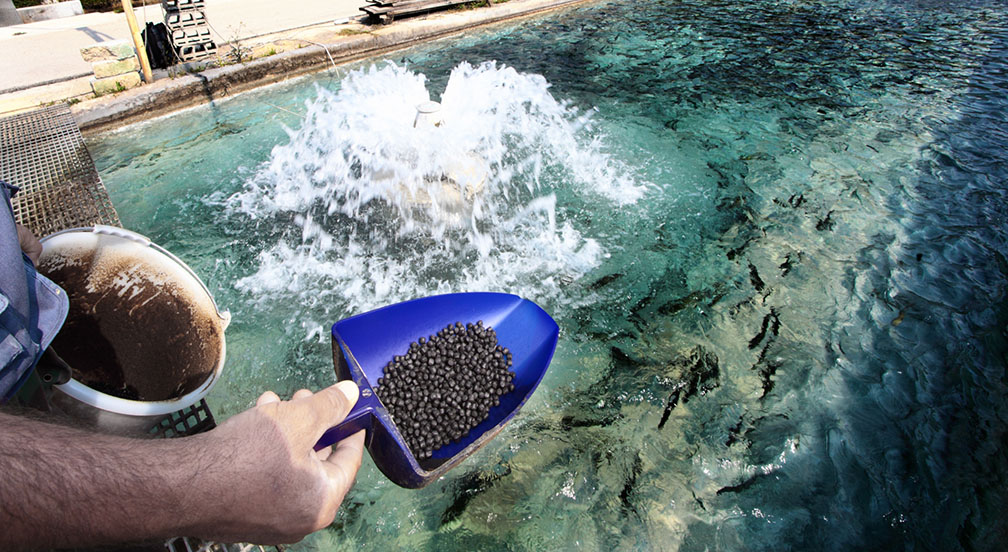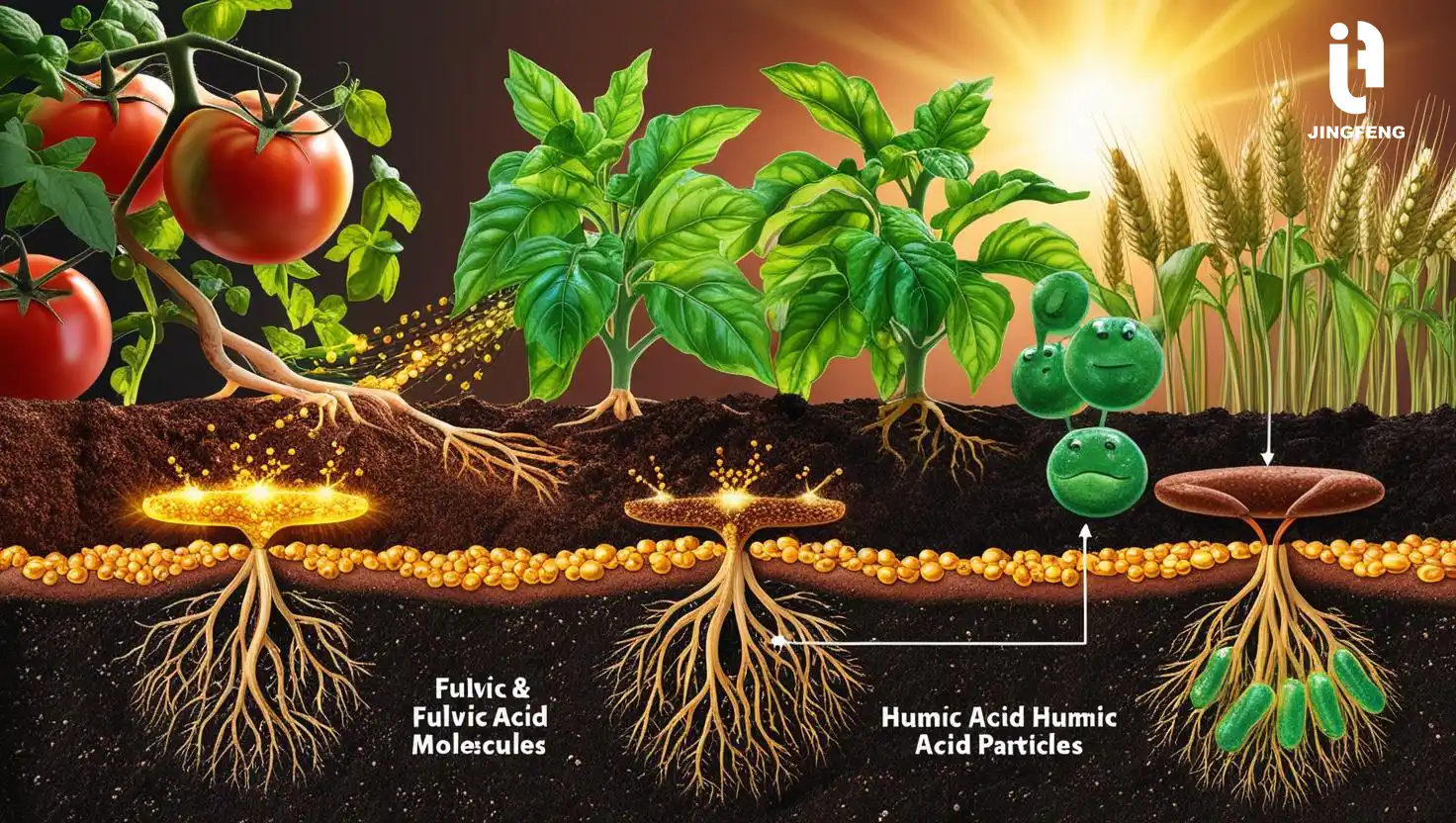
In the quest for thriving gardens and robust crops, the spotlight is now on two remarkable natural compounds—fulvic and humic acid. These organic superheroes are not just trendy buzzwords; they’re essential allies in the battle for optimal soil health and plant growth. Imagine transforming your garden into a verdant paradise, where plants flourish and produce bountiful harvests with the power of these incredible substances. This ultimate guide will unravel the science behind fulvic and humic acids, explaining how they enhance nutrient absorption, improve soil structure, and promote microbial activity. Whether you’re a seasoned gardener or a curious beginner, understanding the benefits of these organic compounds is key to cultivating a healthy ecosystem in your backyard. So, roll up your sleeves and get ready to unlock the untapped potential of your soil—your plants will thank you!
The Science Behind Fulvic and Humic Acid
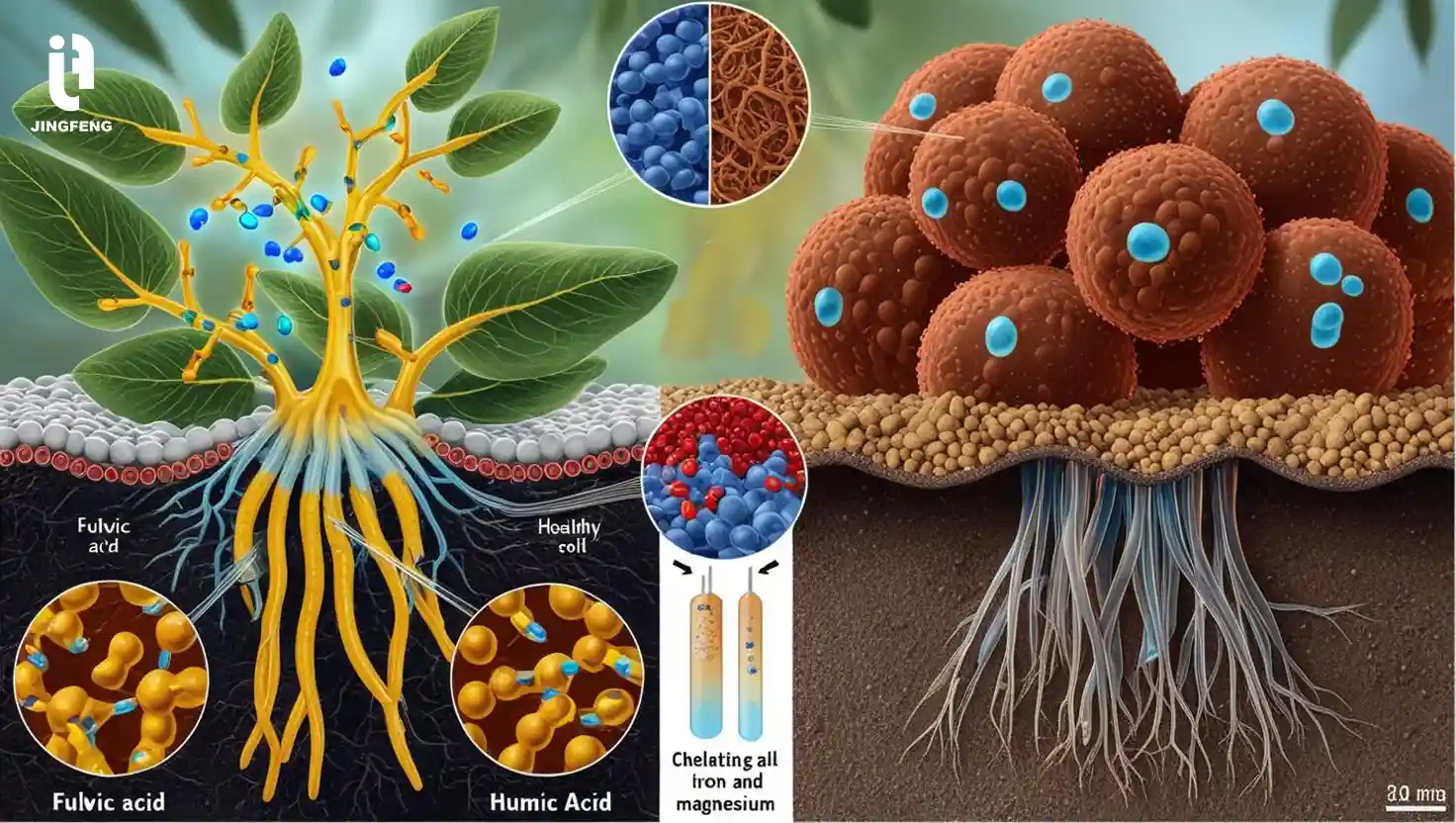 Fulvic and humic acids, although often mentioned together, are unique organic compounds derived from the decomposition of plant and animal materials. These substances are part of a group of compounds known as humic substances, which play a crucial role in soil fertility and plant nutrition. The process of humification, which involves the microbial breakdown of organic matter, results in the formation of these acids. Fulvic acid is a smaller molecule that is soluble in water at all pH levels, whereas humic acid is larger and only soluble in alkaline conditions. Together, they create a dynamic duo that significantly enhances soil properties and plant health.
Fulvic and humic acids, although often mentioned together, are unique organic compounds derived from the decomposition of plant and animal materials. These substances are part of a group of compounds known as humic substances, which play a crucial role in soil fertility and plant nutrition. The process of humification, which involves the microbial breakdown of organic matter, results in the formation of these acids. Fulvic acid is a smaller molecule that is soluble in water at all pH levels, whereas humic acid is larger and only soluble in alkaline conditions. Together, they create a dynamic duo that significantly enhances soil properties and plant health.
The molecular structure of fulvic acid allows it to easily penetrate plant cells, where it facilitates the transport of nutrients and other beneficial compounds. This unique characteristic makes fulvic acid an excellent chelating agent, capable of binding to essential minerals and making them more available to plants. Additionally, fulvic acid’s small size and high reactivity enable it to interact with a wide range of substances in the soil, promoting nutrient uptake and stimulating plant growth.
Humic acid, on the other hand, is renowned for its ability to improve the physical properties of soil. Its larger molecular size contributes to enhancing soil structure by increasing its porosity and water-holding capacity. Humic acid also plays a crucial role in the formation of soil aggregates, which are essential for maintaining soil stability and preventing erosion. Furthermore, humic acid supports the growth of beneficial microorganisms in the soil, fostering a healthy and balanced ecosystem that is conducive to robust plant growth.
Benefits of Fulvic & Humic acid for Soil Health
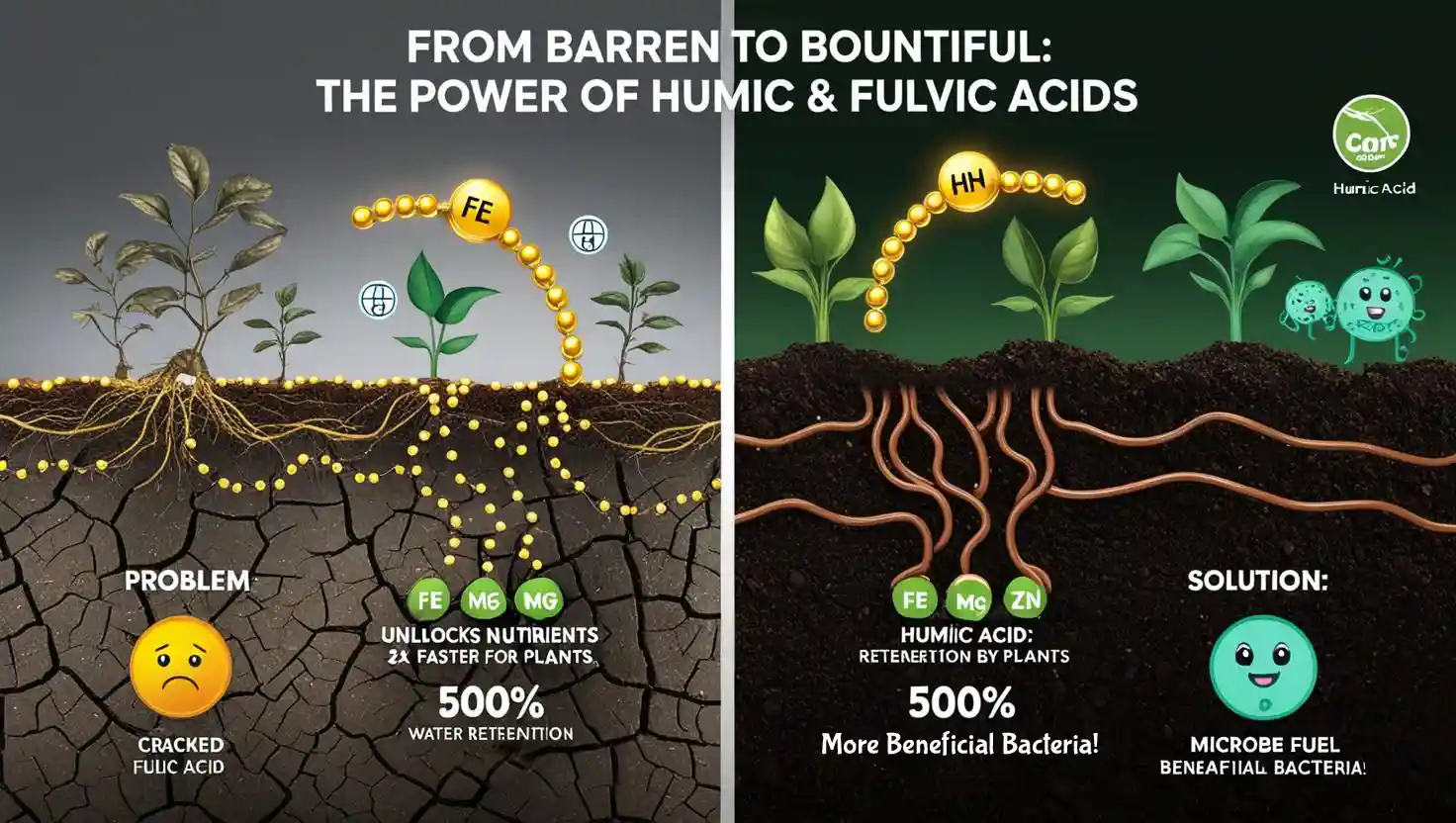 The introduction of fulvic and humic acids into the soil brings about numerous benefits that contribute to overall soil health. One of the most significant advantages is their ability to enhance soil fertility by increasing the availability of essential nutrients. Fulvic acid acts as a natural chelator, binding to minerals like iron, magnesium, and zinc, and making them more readily available for plant uptake. This process ensures that plants receive the necessary nutrients required for optimal growth and development.
The introduction of fulvic and humic acids into the soil brings about numerous benefits that contribute to overall soil health. One of the most significant advantages is their ability to enhance soil fertility by increasing the availability of essential nutrients. Fulvic acid acts as a natural chelator, binding to minerals like iron, magnesium, and zinc, and making them more readily available for plant uptake. This process ensures that plants receive the necessary nutrients required for optimal growth and development.
Humic acid, with its larger molecular structure, has a profound impact on soil physical properties. It enhances soil structure by promoting the formation of stable aggregates, which improve soil aeration and water infiltration. Well-aggregated soil is less prone to compaction, allowing roots to penetrate more easily and access water and nutrients. Additionally, humic acid increases the soil’s water-holding capacity, reducing the need for frequent irrigation and helping plants withstand periods of drought.
Another crucial benefit of fulvic and humic acids is their role in fostering a healthy soil microbiome. These organic compounds serve as a food source for beneficial soil microorganisms, including bacteria and fungi, which are essential for nutrient cycling and disease suppression. By promoting microbial activity, fulvic and humic acids help create a balanced and resilient soil ecosystem. This microbial diversity not only enhances nutrient availability but also aids in breaking down organic matter, further enriching the soil with valuable nutrients.
How Fulvic & Humic acids Enhance Plant Growth
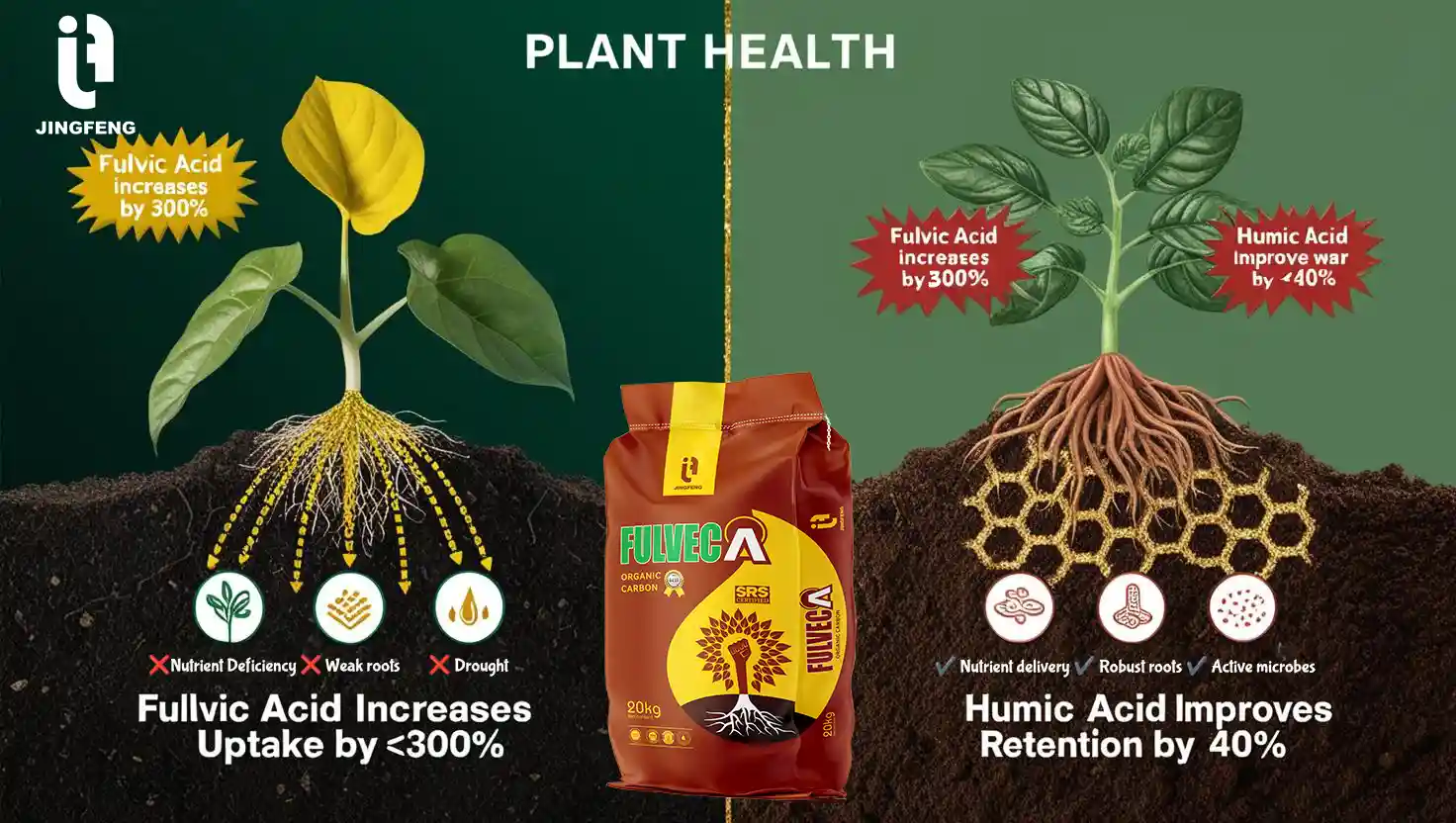 The impact of fulvic and humic acids on plant growth is profound and multi-faceted. One of the most notable effects is the improvement in nutrient uptake efficiency. Fulvic acid’s chelating properties allow it to bind to essential minerals and transport them directly into plant cells. This increased nutrient availability ensures that plants receive a consistent supply of vital elements, promoting healthier and more robust growth. Additionally, fulvic acid enhances the plant’s ability to absorb water, leading to improved hydration and overall vitality.
The impact of fulvic and humic acids on plant growth is profound and multi-faceted. One of the most notable effects is the improvement in nutrient uptake efficiency. Fulvic acid’s chelating properties allow it to bind to essential minerals and transport them directly into plant cells. This increased nutrient availability ensures that plants receive a consistent supply of vital elements, promoting healthier and more robust growth. Additionally, fulvic acid enhances the plant’s ability to absorb water, leading to improved hydration and overall vitality.
Humic acid’s contribution to plant growth is equally significant. By improving soil structure, humic acid creates an ideal environment for root development. Well-aggregated soil allows roots to grow more extensively and access water and nutrients more efficiently. Moreover, humic acid stimulates root exudation, a process where plants release organic compounds into the soil to attract beneficial microorganisms. These microorganisms, in turn, enhance nutrient cycling and protect plants from harmful pathogens, further supporting healthy plant growth.
Another critical aspect of fulvic and humic acids’ influence on plant growth is their role in enhancing stress tolerance. Plants treated with these acids exhibit increased resistance to environmental stresses such as drought, salinity, and extreme temperatures. Fulvic acid, with its small molecular size, can penetrate plant cells and improve their metabolic processes, making plants more resilient to adverse conditions. Humic acid, by improving soil water retention and fostering a healthy microbial community, further supports plants in withstanding stress and maintaining optimal growth.
Differences Between Fulvic and Humic
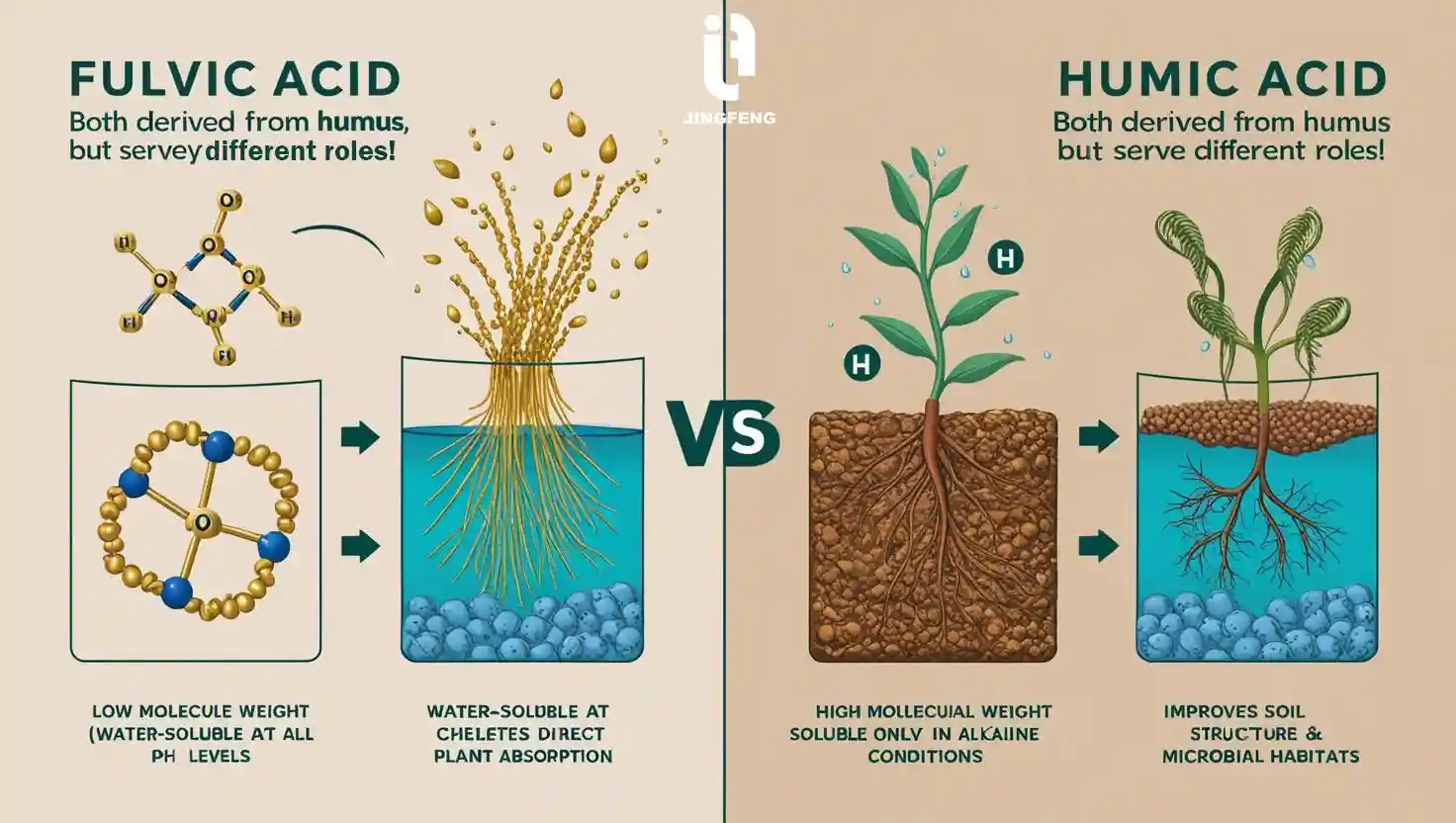 While fulvic and humic acids share many similarities, they also have distinct differences that contribute to their unique roles in soil health and plant growth. One of the primary differences lies in their molecular size and solubility. Fulvic acid is a smaller molecule that is soluble in water at all pH levels, making it highly mobile and easily absorbed by plant roots. In contrast, humic acid is a larger molecule that is only soluble in alkaline conditions, which limits its mobility but enhances its ability to improve soil structure.
While fulvic and humic acids share many similarities, they also have distinct differences that contribute to their unique roles in soil health and plant growth. One of the primary differences lies in their molecular size and solubility. Fulvic acid is a smaller molecule that is soluble in water at all pH levels, making it highly mobile and easily absorbed by plant roots. In contrast, humic acid is a larger molecule that is only soluble in alkaline conditions, which limits its mobility but enhances its ability to improve soil structure.
The chemical composition of fulvic and humic acids also differs, contributing to their unique properties and functions. Fulvic acid contains a higher proportion of oxygen-containing functional groups, such as carboxyl and hydroxyl groups, which give it strong chelating abilities. These functional groups allow fulvic acid to bind to essential minerals and transport them into plant cells, enhancing nutrient uptake. Humic acid, on the other hand, has a higher carbon content and a more complex structure, which enables it to improve soil physical properties and support microbial activity.
Another key difference between fulvic and humic acids is their impact on plant physiology. Fulvic acid’s small size and high reactivity allow it to penetrate plant cells and influence various metabolic processes. This ability makes fulvic acid particularly effective in enhancing nutrient uptake, promoting root growth, and improving stress tolerance. Humic acid, with its larger molecular size, primarily affects soil properties and microbial activity. By improving soil structure and fostering a healthy microbial community, humic acid creates an optimal environment for plant growth and development.
Ways to Apply Fulvic & Humic acid in Agriculture
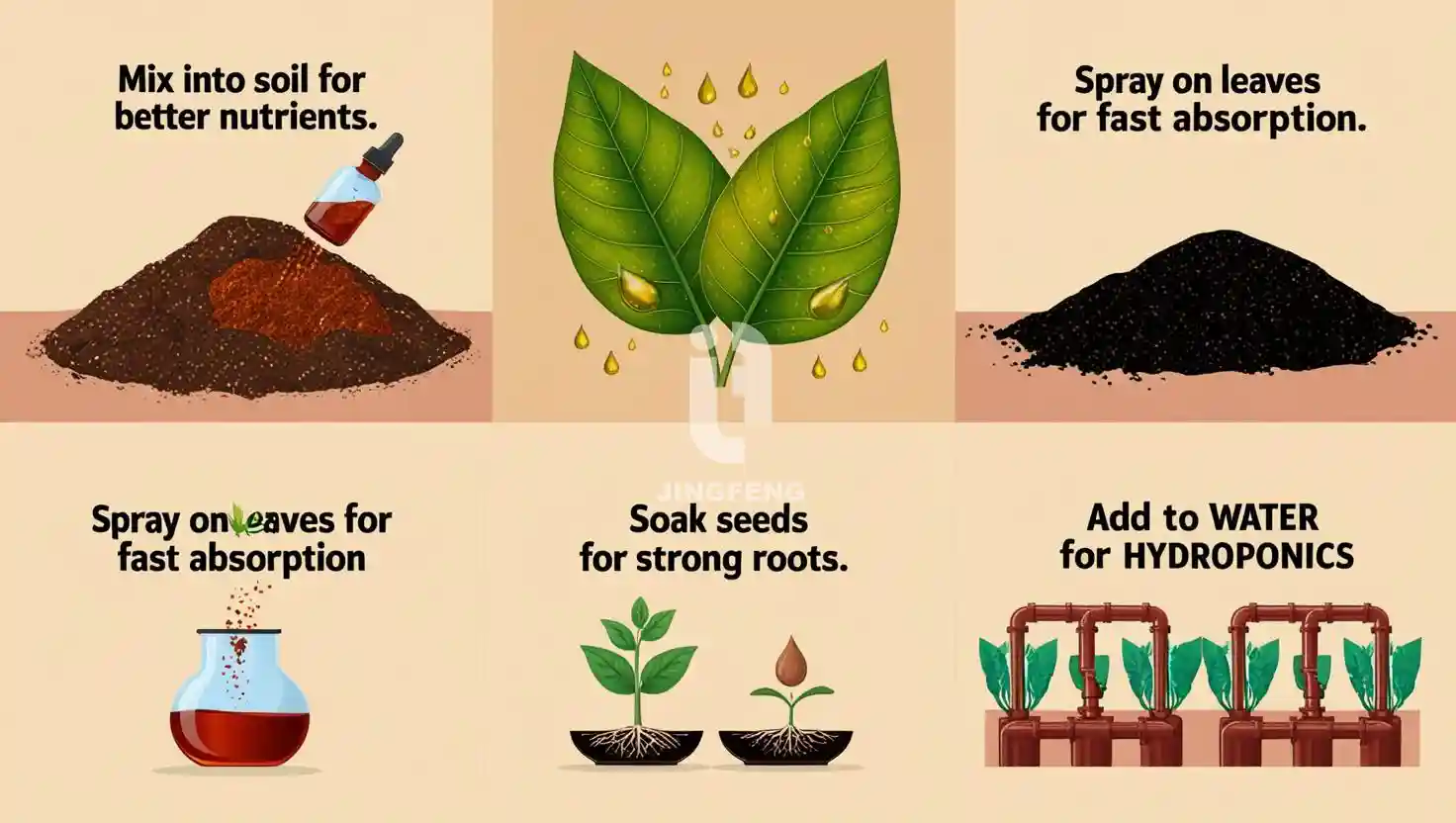 There are several methods for applying fulvic and humic acids in agriculture, each with its advantages and considerations. One common approach is soil application, where these acids are incorporated into the soil to improve its physical and chemical properties. This method involves mixing fulvic and humic acid products with soil or applying them as a liquid solution to the soil surface. Soil application is particularly effective for enhancing soil structure, increasing nutrient availability, and promoting microbial activity.
There are several methods for applying fulvic and humic acids in agriculture, each with its advantages and considerations. One common approach is soil application, where these acids are incorporated into the soil to improve its physical and chemical properties. This method involves mixing fulvic and humic acid products with soil or applying them as a liquid solution to the soil surface. Soil application is particularly effective for enhancing soil structure, increasing nutrient availability, and promoting microbial activity.
Another popular method is foliar application, where fulvic acid is sprayed directly onto plant leaves. This approach allows plants to absorb the nutrients and beneficial compounds in fulvic acid through their stomata, leading to rapid and efficient nutrient uptake. Foliar application is especially useful for addressing nutrient deficiencies and providing plants with a quick boost during critical growth stages. It can also help improve plant resilience to environmental stresses, such as drought or disease.
Seed treatment is another method for utilizing fulvic and humic acids in agriculture. This technique involves soaking seeds in a solution containing these acids before planting. Seed treatment with fulvic and humic acids can enhance seed germination, promote early root development, and improve overall plant vigor. By providing young plants with an early advantage, seed treatment can lead to more robust and resilient crops.
Choosing the Right Fulvic and Humic Acid Products
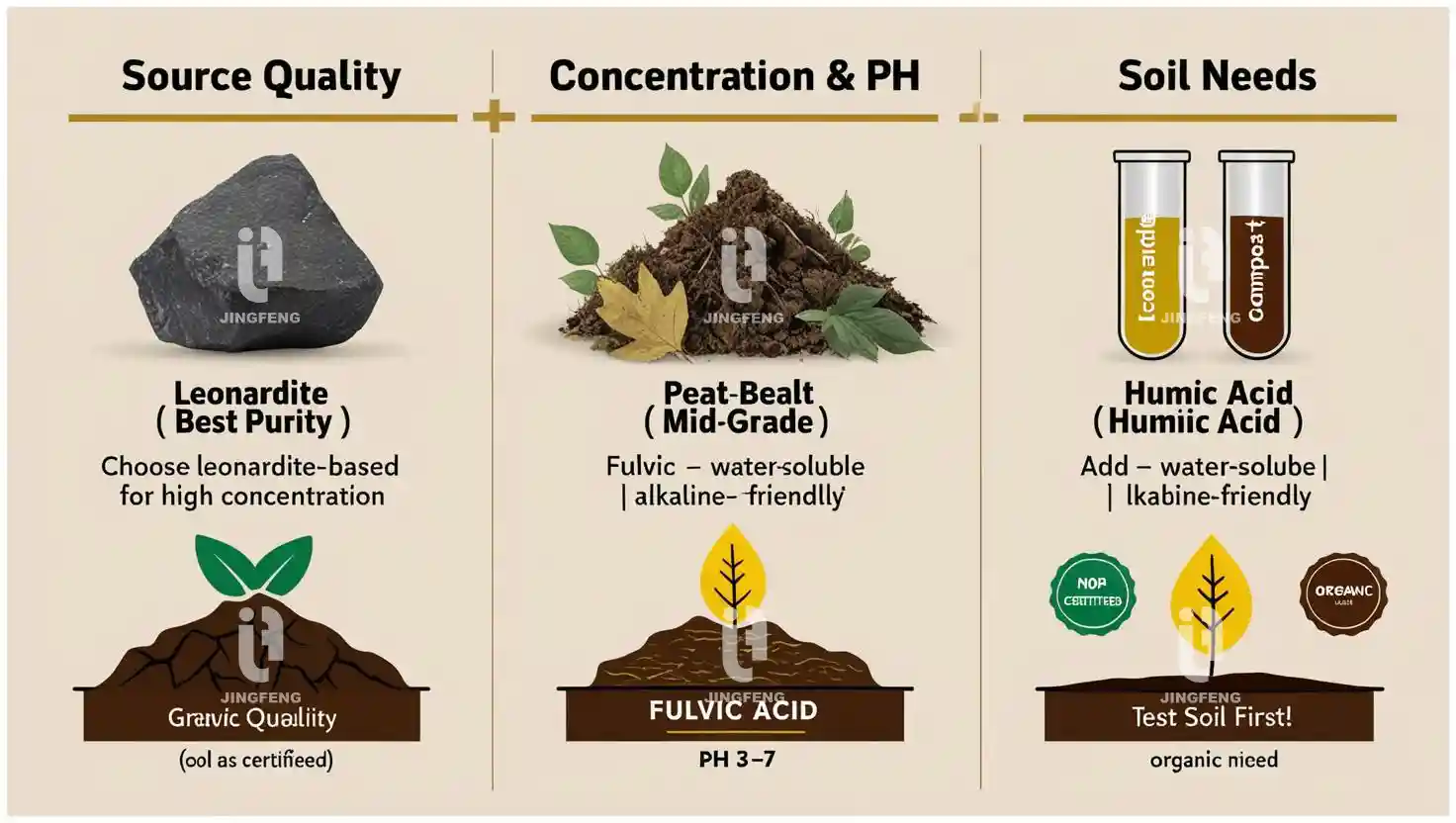 Selecting the right fulvic and humic acid products is crucial for achieving the desired benefits in soil health and plant growth. When choosing these products, it’s essential to consider their source, quality, and concentration. Fulvic and humic acids can be derived from various sources, including leonardite, peat, and compost. Products sourced from high-quality raw materials, such as leonardite, tend to have higher concentrations of active compounds and greater efficacy.
Selecting the right fulvic and humic acid products is crucial for achieving the desired benefits in soil health and plant growth. When choosing these products, it’s essential to consider their source, quality, and concentration. Fulvic and humic acids can be derived from various sources, including leonardite, peat, and compost. Products sourced from high-quality raw materials, such as leonardite, tend to have higher concentrations of active compounds and greater efficacy.
The concentration of fulvic and humic acids in a product is another important factor to consider. Products with higher concentrations of these acids are generally more effective and require lower application rates. It’s also essential to check the product’s pH level, as this can influence the solubility and effectiveness of fulvic and humic acids. For example, fulvic acid products should be water-soluble at all pH levels, while humic acid products are typically more effective in alkaline conditions.
When evaluating fulvic and humic acid products, it’s also helpful to consider the specific needs of your soil and crops. Some products are formulated to address particular issues, such as nutrient deficiencies or soil compaction, and may contain additional beneficial ingredients. Consulting with agricultural experts or conducting soil tests can help determine the most suitable products for your specific situation. By choosing high-quality fulvic and humic acid products tailored to your needs, you can maximize the benefits of these organic compounds and achieve optimal results.
Case Studies: Success Stories from Farmers
 Farmers worldwide have experienced remarkable success by incorporating fulvic and humic acids into their agricultural practices. One notable example is a farmer in the Midwest United States who struggled with poor soil fertility and low crop yields. After applying a combination of fulvic and humic acid products to his fields, he observed a significant improvement in soil structure, nutrient availability, and plant growth. His corn and soybean crops thrived, resulting in higher yields and improved overall profitability.
Farmers worldwide have experienced remarkable success by incorporating fulvic and humic acids into their agricultural practices. One notable example is a farmer in the Midwest United States who struggled with poor soil fertility and low crop yields. After applying a combination of fulvic and humic acid products to his fields, he observed a significant improvement in soil structure, nutrient availability, and plant growth. His corn and soybean crops thrived, resulting in higher yields and improved overall profitability.
In another case, a vineyard owner in France faced challenges with soil compaction and poor water retention, which negatively impacted grape quality and yield. By incorporating humic acid into his soil management practices, he was able to enhance soil aeration and water-holding capacity. The improved soil conditions led to healthier grapevines, better fruit quality, and increased wine production. The vineyard owner also noted that the vines were more resilient to drought and other environmental stresses.
A third success story comes from an organic vegetable farmer in California who struggled with nutrient deficiencies and pest problems. By using fulvic acid as a foliar spray and humic acid as a soil amendment, the farmer saw significant improvements in plant health and pest resistance. The vegetables exhibited vibrant growth, higher nutrient content, and better resistance to pests and diseases. The farmer was able to reduce the use of synthetic fertilizers and pesticides, leading to more sustainable and cost-effective farming practices.
Common Myths and Misconceptions
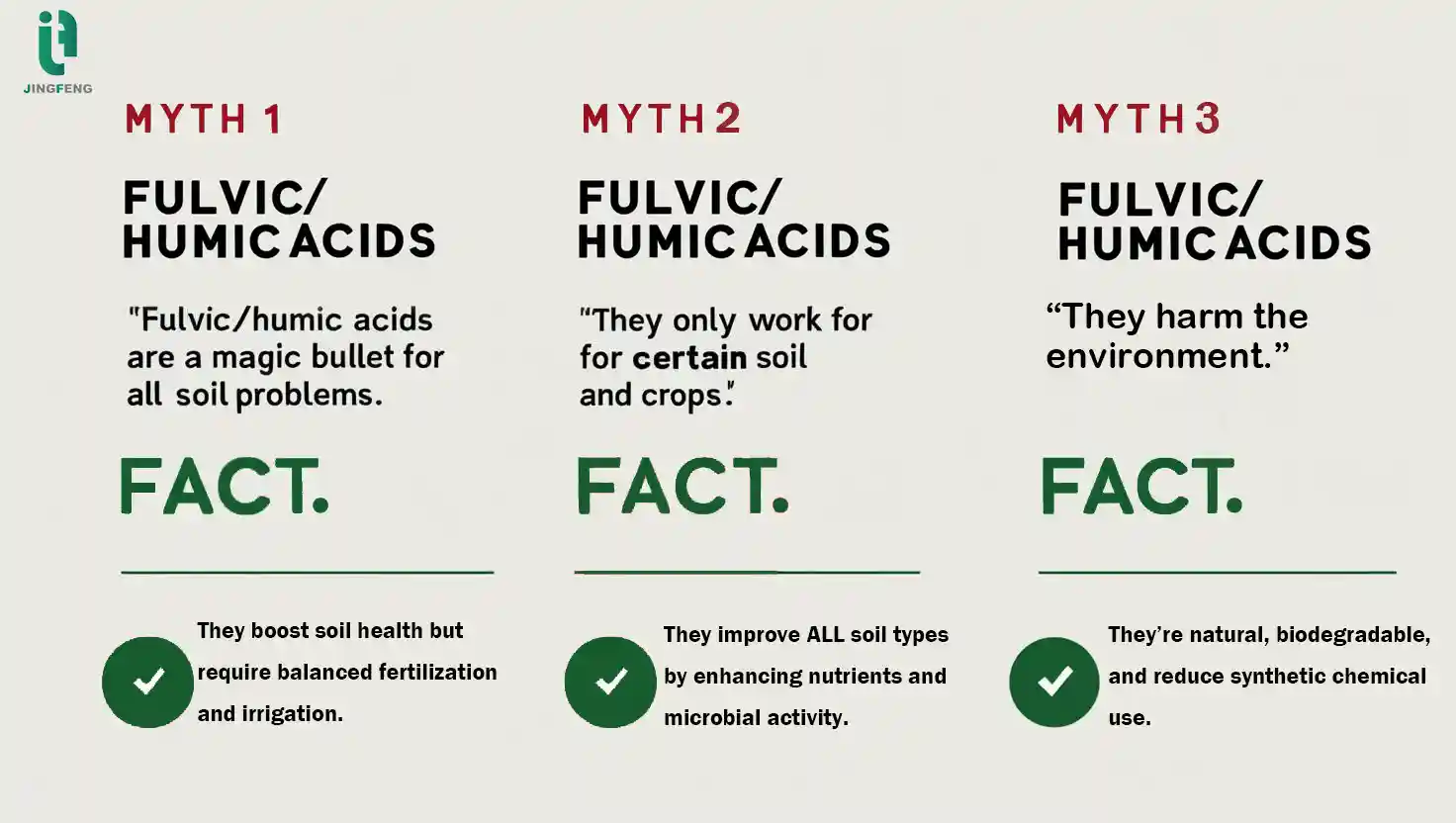 Despite the proven benefits of fulvic and humic acids, several myths and misconceptions persist. One common myth is that these acids are a “magic bullet” that can solve all soil and plant health problems. While fulvic and humic acids are powerful tools for improving soil fertility and plant growth, they are not a cure-all. Successful soil and crop management requires a holistic approach that includes proper fertilization, irrigation, and pest control practices.
Despite the proven benefits of fulvic and humic acids, several myths and misconceptions persist. One common myth is that these acids are a “magic bullet” that can solve all soil and plant health problems. While fulvic and humic acids are powerful tools for improving soil fertility and plant growth, they are not a cure-all. Successful soil and crop management requires a holistic approach that includes proper fertilization, irrigation, and pest control practices.
Another misconception is that fulvic and humic acids are only beneficial for certain types of soil or crops. In reality, these acids can improve soil health and plant growth in a wide range of agricultural settings, from conventional to organic farming. Their ability to enhance nutrient availability, improve soil structure, and promote microbial activity makes them valuable for various soil types and crop systems. Farmers should consider their specific needs and conditions when incorporating fulvic and humic acids into their practices.
A third myth is that fulvic and humic acids are harmful to the environment. On the contrary, these organic compounds are derived from natural sources and are biodegradable. Their use in agriculture can reduce the need for synthetic fertilizers and pesticides, leading to more sustainable and environmentally friendly farming practices. By promoting soil health and supporting beneficial microorganisms, fulvic and humic acids contribute to a balanced and resilient ecosystem.
Conclusion: Harnessing the Power of Fulvic and Humic for Sustainable Farming
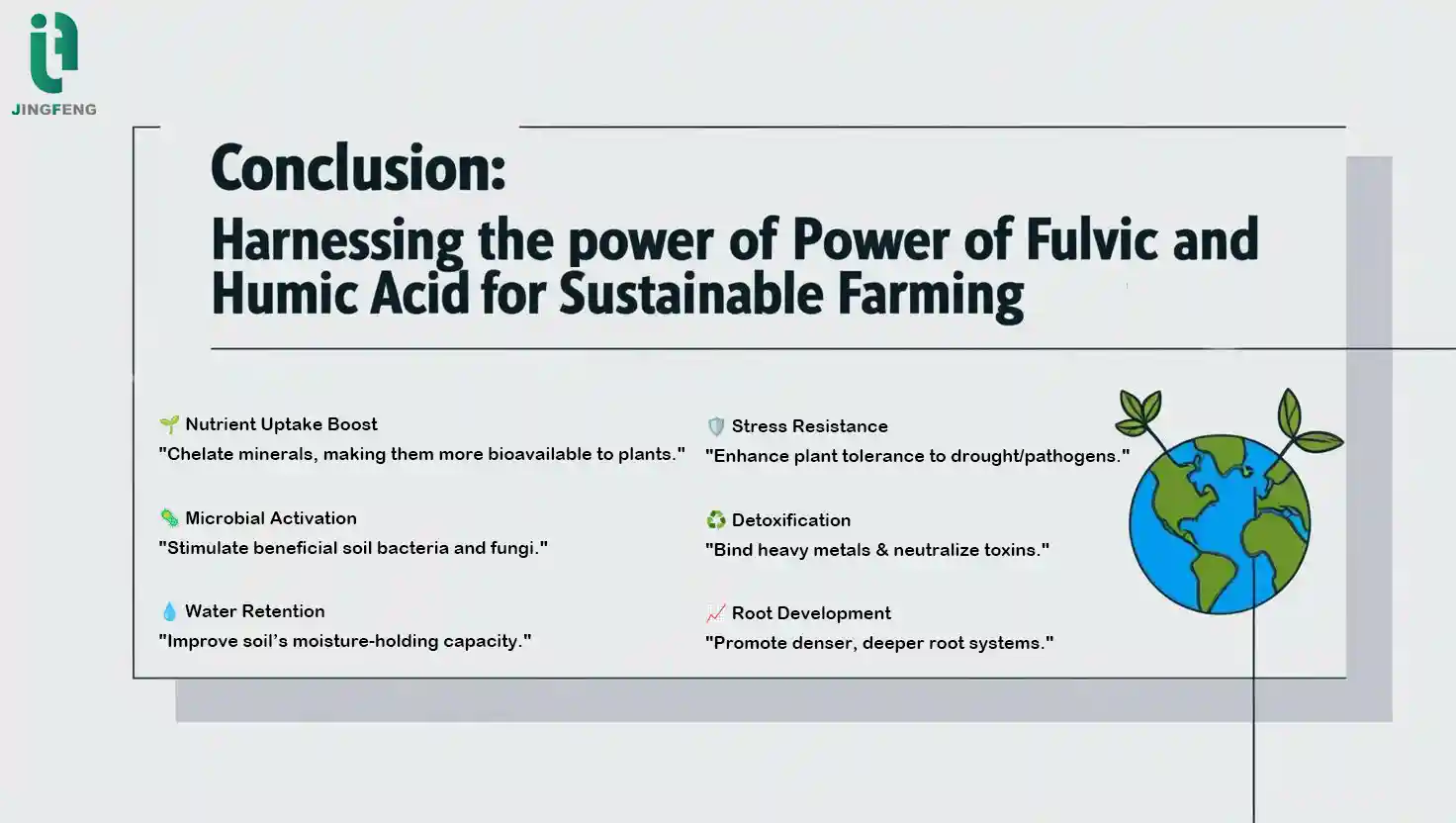 In conclusion, fulvic and humic acids offer a wealth of benefits for soil health and plant growth, making them indispensable tools for modern agriculture. By understanding the science behind these organic compounds and their unique roles, farmers and gardeners can harness their full potential to create thriving and sustainable ecosystems. The ability of fulvic and humic acids to enhance nutrient uptake, improve soil structure, and promote microbial activity can lead to healthier plants, higher yields, and more resilient crops.
In conclusion, fulvic and humic acids offer a wealth of benefits for soil health and plant growth, making them indispensable tools for modern agriculture. By understanding the science behind these organic compounds and their unique roles, farmers and gardeners can harness their full potential to create thriving and sustainable ecosystems. The ability of fulvic and humic acids to enhance nutrient uptake, improve soil structure, and promote microbial activity can lead to healthier plants, higher yields, and more resilient crops.
Choosing the right fulvic and humic acid products and applying them effectively are crucial steps in maximizing their benefits. By considering factors such as source, quality, and concentration, and tailoring the application methods to specific needs, farmers can achieve optimal results. Success stories from farmers around the world demonstrate the transformative impact of fulvic and humic acids on soil health and crop productivity.
Dispelling common myths and misconceptions about fulvic and humic acids is essential for promoting their widespread adoption. These natural compounds are not a panacea but are powerful components of a holistic approach to soil and crop management. Their use in agriculture can contribute to more sustainable and environmentally friendly practices, supporting the long-term health of our soils and the resilience of our food systems.
As we continue to face challenges such as soil degradation, climate change, and growing food demands, the importance of sustainable farming practices becomes increasingly clear. Fulvic and humic acids offer a promising solution for enhancing soil fertility and plant growth, helping to secure a productive and sustainable agricultural future. By unlocking the power of these organic compounds, we can cultivate healthier soils, more robust plants, and a more resilient food system for generations to come.


